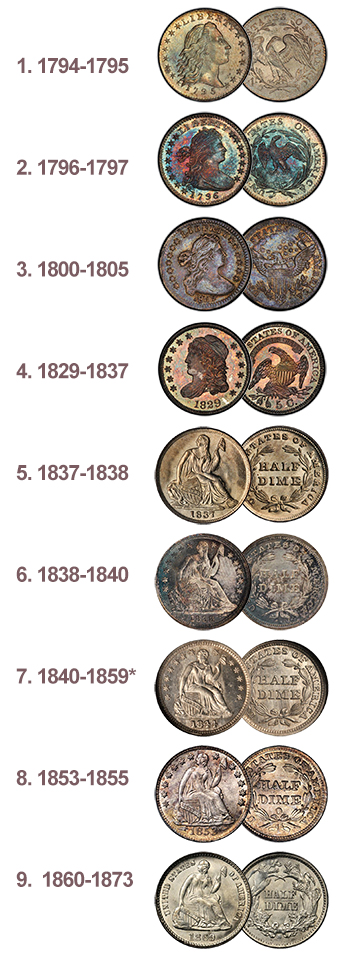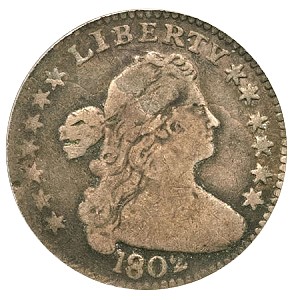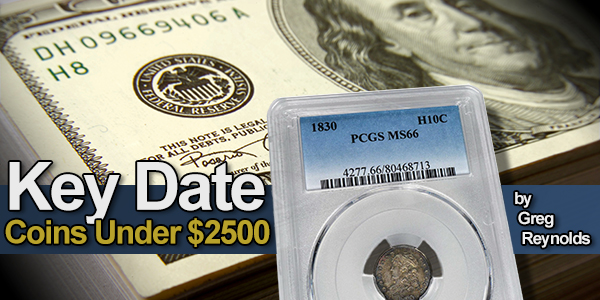Coin Rarities & Related Topics: News and Analysis regarding scarce coins, coin markets, and the coin collecting community #340
A Weekly CoinWeek Column by Greg Reynolds ……
During the history of coin collecting in the United States, most coin enthusiasts at one time or another have sought to complete, or nearly complete, a set of a particular type of U.S. coin. Usually, the scarcest and most famous coins in sets are regarded as ‘key dates,’ some of which are legendary. Almost all key and ‘semi-key’ date half dimes can be purchased for less than US$2,500 each, often for much less.
Herein, information for beginners and intermediate-level collectors is provided. A suggestion for everyone is that half dimes are good values for collectors in the current market environment. Many are rare and all are fascinating historical curiosities.
Generally, a large number of classic U.S coins are worth more than $10,000 each. Indeed, major auctions often include hundreds of coins that each sell for more than $10,000. Moreover, dozens of U.S. coins are worth more than $1 million each. It is refreshing that many key date coins may be acquired for less than $2,500 each. In Part One, the focus was on copper coins, including ‘bronze’ issues.
Research for the present analysis revealed that it is not very difficult to assemble a set of half dimes ‘by date’ (including U.S. Mint locations), from the first half dimes in 1794 all the way to the end of the half dime denomination in 1873. Just three to five issues would have to be excluded from a whole set, given a $2,500-per-coin limitation. Also, most all Capped Bust and Liberty Seated half dimes can be obtained for less than $300 each, many for less than $60 in low grades.
The Nature of Half Dimes
Half dimes are five-cent silver coins that are smaller than dimes. All Liberty Seated half dimes are 90% silver, as are all dimes dated from 1837 to 1964. Before a new law was implemented in 1837, U.S. silver coins, including half dimes, were specified to consist of an alloy of 89.24% silver (‘1485/1664’) and 10.76% copper.
Although half dimes each have a face value of five cents, they are much different from five-cent nickels, which consist of a 25% nickel alloy. Essentially, each half dime was specified to be half the weight of a dime minted in accordance with then-prevailing coinage standards as dictated by law.
 There are nine design types of half dimes:
There are nine design types of half dimes:
- Flowing Hair (1794-95);
- Draped Bust, Small Eagle (1796-97);
- Draped Bust, Heraldic Eagle (1800-05);
- Capped Bust (1829-37);
- Liberty Seated, No Stars (1837-38);
- Liberty Seated, With Stars, No Drapery (1838-40);
- Liberty Seated, With Stars, With Drapery, No Arrows (1840-1859, except 1854-55);
- Liberty Seated, With Arrows (1853-55);
- Liberty Seated, Legend on Obverse (front) – 1860-73.
In past articles, it was explained that 1792 half dismes are patterns, not regular issues.
What are Key Dates?
Key dates are most important to collectors who are building sets, or have done so. Famous keys, though, are often acquired for other reasons. Some collectors are drawn to rarities or relatively scarce coins. After all, a collection of ‘key dates’ and semi-keys would be distinctive and entertaining.
Before discussing ‘key dates,’ it is important to reflect upon the definition of the term ‘date’.
In everyday life, people generally think of the word ‘date’ as referring to a specific day, month and year. Furthermore, historians often use the word ‘date’ to refer to just a specific year, and the numerals of the year on a coin are sometimes called ‘the date’. Collecting ‘by date,’ however, means collecting by year and U.S. Mint location, along with recognized, readily apparent overdates and particular major varieties in some series that traditionally have the status of distinct dates.
There are some varieties that are of the same design type, denomination and year, yet are so different that they each constitute a ‘date’ of the same year. A 1909 VDB Lincoln cent and a 1909-S VDB Lincoln are two different dates. A 1909-S VDB is a key date, while a 1909 VDB is not a key date. A 1909-S VDB Lincoln cent and a 1909-S (without a VDB) are two different dates as well.
In the series of Standing Liberty quarters, a 1917 of the first design type, a 1917-D of the first design type, a 1917-S of the first design type, a 1917 of the second design type, a 1917-D of the second design type, a 1917-S of the second design type, a 1918, a 1918-D, a 1918/7-S overdate, and a 1918-S ‘normal date’ are 10 distinct dates.
Some guides refer to a ‘date’ as just a year on a coin. In the context of completing sets, this ‘date as a year’ definition is inaccurate. If the use of the word ‘date’ in the PCGS registry were valid, a 1916-D Mercury dime and a 1916 Mercury dime without a mintmark would be of the same date. After all, only one or the other is needed for a complete “Mercury Dimes Date Set” in the PCGS registry (and for a similar set in the NGC registry).
The truth is that the 1916-D is widely accepted as a key date and the 1916 Philadelphia Mint Mercury dime is one of the more common pre-1934 dimes. Therefore, for the 1916-D Mercury dime to be a key date and the 1916 to not be a key, these must be two different dates of the same design type, denomination and year.
Keys and Semi-Keys
The queen of key date half dimes is the 1802 and even the worst-known 1802 would cost far more than $2,500. In the series of Capped Bust half dimes, there are no keys. Indeed, all the dates are readily available. A set of Capped Bust half dimes could be assembled for less than $100 per coin, with coins that grade below Fine-12.
The 1838-O is the key to the Liberty Seated, No Stars type, which lasted for just two years. PCGS reports having graded 87 1838-O half dimes, and NGC lists just 44 has having received numerical grades. This total of 131 perhaps includes 95 different coins, at most. It’s likely that there are another 50 to 100 that are non-gradable and/or have never been submitted to PCGS or NGC. Those who collect Liberty Seated coins in Good-04 to VF-20 grades often prefer coins that are not encapsulated.
There are 125 to 195 1838-O half dimes in existence now. This is clearly a very rare coin that is not properly recognized as such.
The meaning of rarity is discussed in a recent article about extremely rare Liberty Head quarter eagles. If fewer than 500 exist, a coin is rare, and a coin is extremely rare if fewer than 100 are known.
In March 2015, Stack’s-Bowers auctioned a PCGS-graded VF-20 1838-O for $616.88. In January 2015, Heritage sold a PCGS-graded VF-20 1838-O for $763.75. In November 2015, Stack’s-Bowers auctioned a PCGS-graded EF-40 1838-O for $1,410.
In 2012, after my article on the unrecognized importance of 1846 dimes was published, multiple collectors pointed out to me that the 1846 half dime is an unrecognized rarity, too. I then estimated that 335 1846 dimes exist, and noted that another expert figured “200 to 250.”
On PCGS CoinFacts, Ron Guth notes that the “1846 Half Dime is the key to the pre-Civil War Half Dimes and has the lowest mintage, by far, of any date prior to 1863.” The PCGS CoinFacts “survival estimate” of “250” is noteworthy, though too high.
PCGS has graded 101; NGC, 58. The combined total of 159 “grading events” refers to less than 125 different coins. NGC data indicates only nine non-gradable 1846 half dimes in ‘details’ holders. “This issue doesn’t seem to have that many problem coins,” remarks a specialist in rare, circulated silver coins of the 19th century.
There are not as many non-certified Liberty Seated half dimes around as there are raw Liberty Seated dimes, which have always been more popular. It is unlikely that there could be as many as 215 1846 half dimes in existence; perhaps the total lies somewhere between 180 and 205.
In September 2015, the Goldbergs auctioned a PCGS-graded Fine-12 1846 for $1,351. In January 2015, Heritage sold a PCGS-graded VF-25 1846 for $2,115.
There are several ‘better date’ Philadelphia Mint, Liberty Seated half dimes from the 1860s, especially those dating from 1863 to 1867. The 1864, 1865, 1866 and 1867 could all be fairly categorized as semi-keys. Some researchers may argue that the 1864 and the 1867 are key dates. A MS-64- or MS-63-grade 1864 could be purchased for well under $2,500 if one is offered in the near future, while a MS-63 grade 1846 would probably cost more than 10 times as much.
In lower circulated grades, 1863 to 1867 Philadelphia Mint issues are much rarer than their San Francisco Mint counterparts. Finding a gradable, circulated 1864 for less than $1,000 might take time.
In July 2015, Stack’s-Bowers auctioned a PCGS-graded EF-40 1864 for $998.75. About three-and-a-half years ago, in January 2013, Heritage sold a PCGS-graded VF-35 1864 with a CAC sticker for $763.75.
In April 2016, Heritage auctioned an 1864 in a PCGS “Genuine” holder, which is said to have “Damage,” with “VF Details.” It brought just $423, though this coin may have been seriously harmed.
While a certified “MS-65” grade 1867 half dime might be found soon, for less than $2,500, finding a sub-53 grade 1867 for less than $900 could very well take months or years. The coin firm GreatCollections sold a CAC-approved, PCGS-graded AU-58 1867 for $1,705 on April 24, 2016.
In September 2015, the Goldbergs auctioned a PCGS-graded Good-04 1867 for $564. It is likely, though, to be extremely difficult to buy a Good grade 1867, as that is the only one that has been graded by PCGS. NGC has also graded one 1867 half dime as Good-04 grade and zero as Good-06. Both services report having graded just a couple in Very Good grades and ZERO in Fine-12 and -15 grades.
Of course, there are some circulated 1867 half dimes that have never been submitted to PCGS or NGC. Even so, sub-53 grade 1867 half dimes are extremely rare. Curiously, 1864-S to 1867-S half dimes are much more plentiful in sub-53 grades than their Philadelphia Mint counterparts from 1864 to 1867, respectively.
The numismedia.com price guide values a Good-04 grade 1864 at $390 and a Good-04 grade 1864-S at $39 – literally one-tenth as much. An 1866 likewise is there, valued at $330 in Good-04 grade, while the 1866-S is valued at one-eleventh as much, $30.
Fortunately for collectors of half dimes, there are not any other Liberty Seated issues that are very expensive. The unique 1870-S half dime is here being ignored.
The 1853-O ‘Without Arrows’ is a semi-key. On July 27, 2014, GreatCollections auctioned a PCGS-graded AG-03 1853-O ‘Without Arrows’ half dime for $203.50. In January 2015, Heritage auctioned a PCGS-graded VF-25 1853-O ‘Without Arrows’ for $1,175.
Nearly Completing a Set of All Half Dimes
With a $2,500-per-coin limit, the already-mentioned 1802 and 1870-S must be omitted. The 1796/5 overdate and the 1797-‘13 Stars Obverse’ would probably have to be excluded as well.
 It may not be possible to acquire an 1803 ‘Small 8’ half dime for less than $2,500. The 1803 ‘Small 8’ should not, however, be classified as a date in addition to the 1803 ‘Large 8.’ There is not much of a difference in the numerals, and both these 1803 varieties are really of the same date. For there to be two different dates of the same type, denomination and year, the differences have to be readily apparent and substantial.
It may not be possible to acquire an 1803 ‘Small 8’ half dime for less than $2,500. The 1803 ‘Small 8’ should not, however, be classified as a date in addition to the 1803 ‘Large 8.’ There is not much of a difference in the numerals, and both these 1803 varieties are really of the same date. For there to be two different dates of the same type, denomination and year, the differences have to be readily apparent and substantial.
It is very much practical to collect all types of half dimes ‘by date’ without spending as much as $2,500 on any one coin. In some cases, collectors may have to settle for non-gradable half dimes.
A gradable or seemingly gradable 1794 can possibly be obtained for less than $2,500. In January 2011, Heritage auctioned a PCGS-graded Good-06 1794, with an old green label (OGH), for $1,955.
Most Very Good-08 to Fine-15 grade 1795 half dimes should cost less than $2,500 each in the current market environment. The 1796 ‘LIKERTY’ variety is a distinct date, as it seems to be the only 1796 half dime issue with normal numerals.
The 1796/5 overdate and the 1796 ‘LIKERTY’ are the only two varieties of half dimes of the year 1796 that I recollect at the moment. Oddly, the 2017 Red Book indicates that there is a third “1796” variety of half dimes, with normal numerals and normal letters.
If 1796 half dimes were struck with a third obverse die, I have never seen one. The 1796 with normal numerals is, by tradition, referred to as ‘LIKERTY.’ There was a minor error relating to the letter ‘B,’ and the unintended consequence is entertaining.
A non-gradable 1796 ‘LIKERTY’ half dime could surely be obtained for well under $2,500. In the just-concluded Summer FUN auction, a 1796 ‘LIKERTY’ variety half dime in a PCGS ‘Genuine’ holder, “Plugged – XF Details,” sold for $1,762.50. Another in a PCGS “Genuine” holder, ‘Damage – Fine Details,’ was auctioned by Stack’s-Bowers for $1,292.50 in August 2015.
In April of this year, a NGC-graded Good-06 1797 (15 Stars) was auctioned for just $1,410. Only June 1, 2014, GreatCollections sold a PCGS-graded VG-08 and CAC-approved 1797 (16 Stars) for $2,389.20.
At the 2016 Spring Long Beach Expo, Heritage auctioned a 1797 (16 Stars) from the recently-emerged collection of the late Dr. James McClure. That 1797 was NGC certified as “VF Details, Damaged,” and realized $587.50.
Last month, a PCGS-graded VG-10 and CAC-approved 1800 was auctioned by Heritage for $1,938.75. A certified, non-gradable 1800 ‘LIBEKTY’ variety could easily be found for less than $2,500, probably for less than $1,000. In September 2015, Heritage auctioned an 1800 in an NGC holder, “Fine Details,” for $822.50.
In sum, excepting the 1796/5, 1797-‘13 Stars,’ 1802 and 1870-S, a representative of every date could surely be obtained for less than $2,500 each. It would be exciting to build a nearly complete set from 1794 to 1873, including multiple design types. Several periods in the history of U.S. coinage and in the history of the nation as a whole would be represented in such a set – in just a single denomination!
©2016 Greg Reynolds





